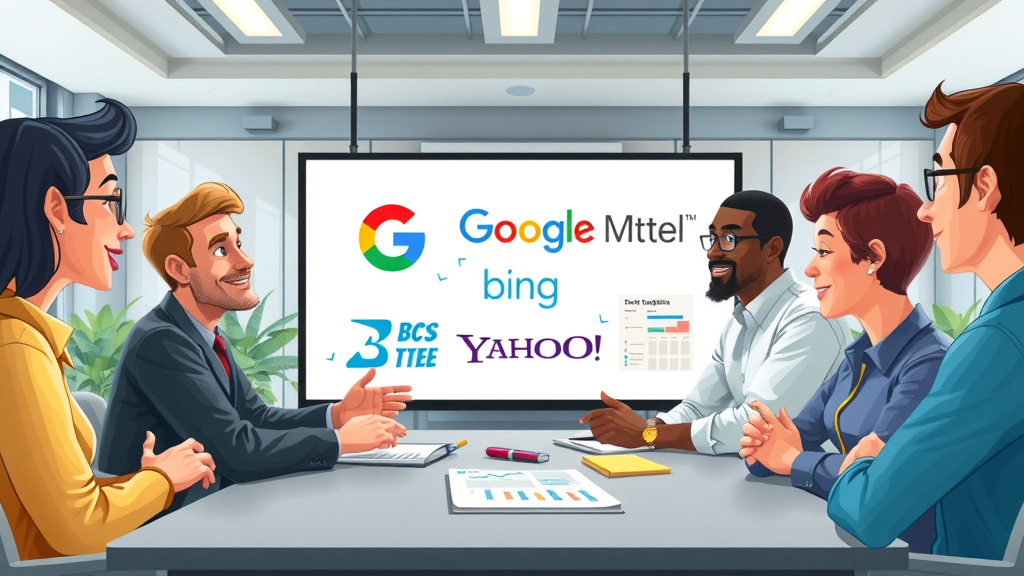
- Did you know that over 93% of online experiences begin with a search engine, and businesses that neglect search engine marketing risk losing more than half their potential customers? Dive in to discover how to maximize your results and avoid the missteps that cost companies millions annually.
What You'll Learn:
- Critical insights into search engine marketing
- Practical SEM strategies for real business growth
- Actionable tips to stay ahead in the search engine market
Imagine losing out on over 50% of your sales simply because your competitors mastered search engine marketing while you didn’t. In today’s digital era, every click matters and a single oversight could cost your business thousands in revenue. This article unpacks the essential knowledge you need to not only avoid the most common (and costly) SEM mistakes, but also to position your brand to thrive in an evolving engine market.
Understanding the Fundamentals of Search Engine Marketing
Navigating the world of search engine marketing starts with a clear understanding of its core components. SEM is the practice of using paid advertising, particularly on major search engines like Google and Bing, to place your web pages directly in front of potential customers searching for your relevant terms. This means instead of waiting for users to stumble upon your business organically, SEM places your brand on the search engine results pages (SERPs) where visibility is highest. For example, a local florist can use Google Ads to appear at the top when someone searches “best roses near me,” effectively capturing buyers at the exact moment they’re ready to purchase.
The importance of search engines in driving web traffic cannot be overstated—after all, over 90% of all online activities begin with a simple search. This hyper-targeted marketing approach measures success by connecting with your target audience when their intent is strongest. When paired with structured keyword research and data-driven ad spending, SEM can deliver immediate, traceable, and scalable growth for businesses of any size.
Defining Search Engine Marketing in the Digital Era

In the past, engine marketing revolved around basic paid ads and static listings. Today, search engine marketing leverages advanced targeting, real-time analytics, and multichannel strategies. SEM is more than just buying a paid ad spot; it’s about integrating paid search, organic search, and conversion optimization—all designed to capture high-intent users on results pages . Modern SEM uses tools like Google Ads to target specific keywords, improve ad ranking, and craft compelling ad copy that resonates with a particular target audience, driving them to thoughtfully designed landing pages that convert.
With features such as audience segmentation, retargeting, and sophisticated bid management, SEM has become a cornerstone of any robust digital marketing plan. Brands who fully embrace the potential of search engine marketing can swiftly drive more qualified visitors, refine their conversion rate, and consistently outpace the competition.
Why Search Engine Marketing is a Game-Changer for Businesses
Search engine marketing stands out because it delivers instant, measurable results. Unlike traditional advertising, which waits for the right eyes to stumble across billboards or flyers, SEM meets the customer in their moment of need. Whether a business serves a local market or competes globally, an effective SEM strategy can unlock new sources of high-converting traffic.
Through precise keyword bidding and careful ad targeting, businesses only pay for actual engagement—every dollar spent can be traced to specific conversions or goals. Furthermore, integrating SEM with web analytics transforms every campaign into a learning opportunity, helping marketers fine-tune messaging and budget allocation for maximum impact on the search engine market . Most importantly, SEM ensures brands remain visible where purchase intent is highest: right on the first page of search engine results pages .
The Search Engine Market: Key Components and Current Trends
Main Players in the Search Engine Market

The search engine market is dominated by a handful of key players, with Google leading the charge by owning more than 90% of global search market share. Bing, Yahoo, and regional engines like Baidu (China) and Yandex (Russia) also command significant followings. Each search engine offers unique features and advertising options, and their respective engine results pages may prioritize different types of content and paid ad placements.
When formulating an SEM strategy, recognizing the influence of each search engine within the broader engine market is critical. Google Ads, for instance, has the largest user base and the most advanced targeting capabilities, making it the go-to platform for most businesses. However, Bing Ads (now Microsoft Advertising) and Yahoo Gemini can offer lower-cost opportunities in certain demographics. Integrating campaigns across multiple platforms allows businesses to capture a more diverse audience and mitigate risks associated with over-reliance on a single engine market player.
Latest Trends Influencing Engine Marketing
Recent trends are rapidly reshaping the dynamics of the engine marketing space. Automation and machine learning are becoming central, with smart bidding strategies, responsive ad formats, and AI-driven optimizations leading the way. Google and Bing platforms now heavily promote automated ad types, such as Smart Campaigns and Performance Max, which leverage real-time data to optimize for conversion rate and ad spend.
Another trend is the increasing overlap between paid search and organic search methods. Marketers are now blending SEM and search engine optimization efforts, capitalizing on shared keyword insights and cross-channel analytics. Additionally, privacy regulations and the deprecation of third-party cookies are pushing for more transparent ad tracking and first-party data strategies. Staying ahead of these shifts is essential for remaining competitive in a rapidly evolving search engine market .
Critical Mistakes in Search Engine Marketing—and How to Avoid Them
Ignoring Keyword Research in Engine Marketing

- Failing to understand search intent
- Overlooking competitor analysis for the search engine market
One of the most damaging missteps in search engine marketing is neglecting thorough keyword research. Many businesses jump into paid advertising without drilling down into which specific keywords their target audience is searching for or which terms are already dominated by competitors. This oversight can lead to wasted ad spend targeting irrelevant keywords or missing out on high-converting opportunities. Understanding user search intent and conducting a thorough competitor analysis are foundational to any successful SEM strategy.
Additionally, skipping keyword research weakens every step of the campaign funnel—from ad copy to landing page design—reducing the overall conversion rate and potentially leading to low-quality scores on Google Ads. Detailed keyword research not only informs the selection of high-value terms with optimal search volume and commercial intent but also delivers insights into seasonal trends, content gaps, and competitor tactics on the search engine market . Ignoring this step is like running a race blindfolded; you’ll never beat the competition or maximize your ROI.
Neglecting the Importance of Paid Search and Google Ads
- Difference between organic search and paid ad approach
- SEM strategy missteps leading to wasted ad spend

Many businesses fall into the trap of prioritizing organic search while overlooking the potential of paid search and Google Ads. While ranking high through SEO is invaluable, the fast-paced world of engine marketing often demands rapid results. Paid search enables brands to instantly appear at the top of search engine results, giving them immediate exposure, while organic search typically takes much longer to gain traction.
Mistakes here often include under-budgeting paid ad campaigns, neglecting ad copy optimization, or mismanaging bidding strategies—each leading to wasted resources and lackluster performance. The most effective SEM strategies balance both paid and organic efforts. A well-executed paid search campaign, such as a Google Ads initiative, ensures that you capture buying intent traffic right as users search for solutions that your business offers, providing a measurable boost to sales and brand awareness in the competitive engine market .
Overlooking the Role of SEO and SEM in Digital Marketing Integration
- Missed opportunities with combined strategies
- Weak brand awareness in a competitive engine market
"In the rapidly evolving world of search engine marketing, a single oversight can result in thousands in wasted budget and countless missed opportunities." — Industry Expert
Treating SEO and SEM as separate silos is a recipe for missed opportunity. The most successful businesses in the search engine market understand that integrating both approaches yields exponentially stronger results. While SEO strengthens long-term domain authority and free traffic, SEM provides short-term wins and fills in gaps between organic rankings. Data insights from paid search campaigns can inform SEO keyword targeting, while high-performing organic content can be amplified using paid ads for faster reach.
Without this integrated approach, brands risk inconsistent messaging, fragmented data streams, and diluted brand awareness . A unified SEM and SEO campaign ensures your overall digital marketing strategy works cohesively, securing a more significant presence on engine results pages and maximizing every marketing dollar spent.
Best Practices for Successful Search Engine Marketing Campaigns
Effective SEM Strategy for Modern Businesses
- Understanding the role of paid search and organic search
- Building a strong foundation with keyword research

A modern SEM strategy starts with detailed keyword research , ensuring your paid search campaigns are targeting the highest-value and most relevant terms for your industry. By understanding the nuance between paid and organic search, marketers can balance short-term lead generation with long-term growth. Building a structured list of negative keywords prevents wasted spend and sharpens campaign focus.
Successful SEM efforts involve setting clear goals, such as improving conversion rate or increasing sales, and tracking progress through analytics platforms. Integrating insights from both paid advertising and organic efforts builds a more robust strategy, with data-driven optimizations refining audience targeting, improving ad copy, and boosting performance on the search engine results pages .
Leveraging Google Ads and Other Paid Ad Platforms
- Optimizing ad copy for conversion in the search engine market
- Budget management for maximum ROI
Google Ads remains the gold standard for paid search campaigns, but exploring additional platforms like Bing Ads can further extend your reach. Writing compelling, benefit-driven ad copy with clear calls to action directly impacts your conversion rate . Utilize features like ad extensions and sitelinks to provide more information within the ad itself, making it easier for users to interact with your brand directly from the results page .
Budget management is equally critical. Carefully monitor your spend, use automated bidding strategies when appropriate, and test various ad creatives to determine the best performing assets. Routinely optimizing campaigns not only minimizes waste but also ensures maximum ROI by aligning expenditure with real business results, especially in competitive sectors within the engine market .
Integrating SEO and SEM for Holistic Results
- Driving traffic with complementary strategies
- Enhancing brand awareness and credibility

The synergy between SEO and SEM cannot be overstated. By leveraging both paid and organic search tactics, marketers ensure visibility in multiple areas on search engine results pages . For example, while a Google Ads campaign targets high-intent commercial queries, organic SEO strengthens your site’s authority for ongoing, cost-effective traffic. This dual approach improves brand credibility, as your business occupies more slots on SERPs and appears more trustworthy to consumers.
Integrated campaigns also enhance resilience to market changes. If a paid campaign’s performance dips due to rising costs or policy changes, organic search can pick up the slack. Simultaneously, data from paid efforts can uncover ‘quick win’ keywords that your SEO strategy can capitalize on longer-term. This holistic approach to search engine marketing ensures that your engine marketing footprint remains strong and adaptable, regardless of shifts in the search engine market .
Case Studies: How Search Engine Marketing Transformed Brands

Real-Life Examples of SEM Success
Companies across industries have transformed their growth trajectories through strategic search engine marketing . For instance, a mid-sized eCommerce brand implemented a blended SEM and SEO approach, using targeted Google Ad campaigns during peak shopping seasons while optimizing web pages for organic search year-round. The result? A 45% lift in conversion rate, increased average order value, and dominance on competitive results pages.
Another success story comes from a SaaS provider who used paid search campaigns focused on branded and competitor keywords, driving direct traffic to conversion-optimized landing pages. By analyzing campaign performance with analytics tools, they reallocated spend to high-performing channels, doubling their qualified lead flow within six months.
| Metric | Before SEM | After SEM Implementation |
|---|---|---|
| Website Traffic | 5,000 visits/mo | 18,000 visits/mo |
| Conversion Rate | 1.2% | 3.4% |
| Cost per Lead | $45 | $19 |
| Brand Ranking on SERP | Page 2 | Top 3 |
Common Questions About Search Engine Marketing

What is search engine marketing?
- Search engine marketing is a branch of digital marketing focused on increasing visibility in search engine results through paid advertising, such as Google Ads, and often integrates with SEO strategies for maximum impact.
What is the difference between SEO and SEM?
- SEO (Search Engine Optimization) refers to organic strategies for improving rankings, while SEM (Search Engine Marketing) encompasses both SEO and paid ad tactics like Google Ads to drive targeted traffic.
How much does SEM cost?
- SEM costs vary based on ad spend, keywords competitiveness, and industry. Budgets can range from $500 monthly for small businesses to over $10,000 for larger campaigns. Efficiency lies in optimizing for the best return on investment.
What is an example of SEM?
- Running a Google Ads campaign for your product keywords to appear at the top of search engine results alongside organic listings is a prime example of search engine marketing in action.
Essential SEM Tools and Resources for Every Marketer
- Keyword research (SEMrush, Ahrefs)
- Paid search management tools (Google Ads Editor, Bing Ads)
- Analytics platforms (Google Analytics, Data Studio)

To excel in search engine marketing , the right technology stack matters. Keyword research tools like SEMrush and Ahrefs identify trending terms and competitive gaps essential for campaign success. Google Ads Editor and Bing Ads streamline the management of paid campaigns, making it easier to launch, edit, and optimize multiple ads simultaneously.
Analytics platforms, such as Google Analytics and Data Studio, offer real-time insights into performance, channel attribution, and user journeys across web pages. Armed with these resources, marketers can iterate and improve their SEM strategy with confidence, ensuring that every dollar spent contributes to their growth objectives in the search engine market .
Actionable Tips for Mastering Search Engine Marketing
- Set clear goals and KPIs for your search engine marketing strategy
- Continually optimize campaigns for performance and cost
- Track and analyze search engine market trends
- Learn from competitors in engine marketing for ongoing improvement

Mastering search engine marketing means going beyond one-time campaign launches. Begin by setting clear objectives and key performance indicators (KPIs), such as target conversion rate, cost per acquisition, or traffic growth. Continual optimization is crucial: test new ad creatives, adjust bidding strategies, and evaluate keyword performance regularly.
Keep a close eye on emerging trends in the search engine market and always be willing to adapt strategies as new features or platforms emerge. Finally, don’t overlook your competitors—conduct regular engine marketing audits to identify tactics that work for others, and iterate on them for your business.
A Roadmap to Long-Term Success in Search Engine Marketing
- Stay current with evolving search engine market algorithms
- Invest in ongoing training for your digital marketing teams
- Balance paid ad and organic search for sustained growth

Long-term SEM success depends on staying ahead of algorithm changes and industry shifts. Invest in continuous education for your marketing team to remain proficient with the latest SEM tools and best practices. Strive for a balanced engine marketing approach—leveraging both paid ad and organic search to build a sustainable digital presence that delivers results year after year.
Evaluate your approach at regular intervals, adapt to the latest algorithm and policy updates, and prioritize cross-disciplinary expertise to maintain a competitive edge in the evolving search engine market .
Frequently Asked Questions on Search Engine Marketing
-
How do I measure SEM performance?
SEM performance is typically measured by tracking metrics such as click-through rate (CTR), cost per click (CPC), conversion rate, and return on ad spend (ROAS) with analytics platforms like Google Analytics or Data Studio. -
What is a good ROI for engine marketing?
A good ROI depends on your industry and objectives, but a strong SEM campaign generally delivers a positive return, ideally generating at least $2 for every $1 spent. -
Can small businesses succeed with search engine marketing?
Absolutely. Small businesses can thrive with a focused SEM strategy, targeting local or niche keywords, and starting with a manageable ad budget to drive tangible results. -
How do I choose the right keywords for the search engine market?
Use keyword research tools to identify terms with high search volume, commercial intent, and reasonable competition. Also, consider long-tail and local-specific keywords for better targeting. -
What is the ideal SEM budget?
There is no one-size-fits-all, but a starting point is allocating 7-15% of anticipated sales or overall marketing spend to SEM. Adjust based on performance analysis over time.
"Search engine marketing is both an art and a science; those who fail to master both risk falling behind in a fiercely competitive digital landscape."
Move Forward with the Right Search Engine Marketing Partner
- Want to boost your visibility and grow your business with expert search engine marketing? Call us at (385) 469-1869 or email at info@solu4u.com today!
Take decisive action—invest time in research, leverage the right SEM tools, and continuously optimize. Partnering with SEM experts ensures you avoid costly mistakes and fuel long-term digital growth.
Sources
- https://www.searchenginejournal.com/beginner-guide-search-engine-marketing/277503/
- https://www.wordstream.com/search-engine-marketing
- https://neilpatel.com/what-is-sem/
To deepen your understanding of search engine marketing (SEM) and its critical role in digital strategy, consider exploring the following authoritative resources:
- “Search Engine Marketing: What is SEM? Why is it Important?” ( advertising.amazon.com )
This guide from Amazon Ads provides a comprehensive overview of SEM, detailing its significance in enhancing brand visibility and driving targeted traffic through paid search strategies.
- “What is search engine marketing (SEM)?” ( optimizely.com )
Optimizely’s article delves into the fundamentals of SEM, explaining how it differs from SEO and outlining the benefits of integrating paid search advertising into your marketing efforts.
By reviewing these resources, you’ll gain valuable insights into effective SEM practices and how to implement them to achieve measurable business growth.
 Add Row
Add Row  Add
Add 




Write A Comment